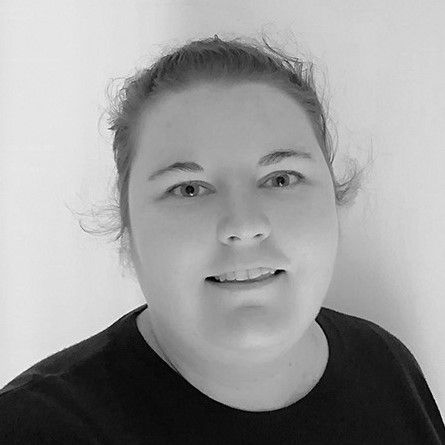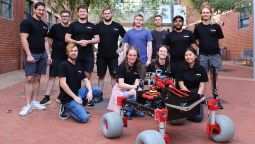Next-gen lightning strike protection devices to save lives

Lightning strikes are getting more common. So it's just as well Dr Hannah J. King is working on the next-generation lightning strike protection devices to stop lightning striking buildings, people, boats and more.
In summary
- Dr Hannah J. King is an Associate Researcher with Surface Engineering for Advanced Materials (SEAM)
- Her science teacher inspired her to pursue a career in science
- She hopes her research into lightning strike protection devices will save lives
Have you noticed more lightning activity of late? Back in 2014, researchers predicted that for every 1°C of global warming, lightning strikes would increase by 12 per cent. And of course, we know lightning strikes can cause bushfires. But evidence also suggests that lightning strikes in urban areas are becoming more common. So, it’s just as well Postdoctoral Fellow at Swinburne Dr Hannah J. King is working on the next-generation lightning strike protection devices to stop lightning striking buildings, people, boats and just about anything else that might get struck.
To celebrate International Day of Women and Girls in Science, we asked Dr Hannah J. King about her journey to becoming an Associate Researcher at The Australian Research Council (ARC) Industrial Transformation Training Centre in Surface Engineering for Advanced Materials (SEAM).
Here's what she had to say.
Tell us about your childhood and the environment you grew up in?
I grew up in Townsville, Queensland. My father was an engineer and my mother a nurse. I went to a high school which had a standard science education. I went to James Cook University in Townsville and studied an undergraduate Bachelor of Science with a double major of Chemistry and Mathematics. I studied honours in Chemistry, then a PhD in Chemistry.
I had all male educators for my chemistry and maths degree, except for one woman maths lecturer. I knew only a few women studying science, and had no exposure of women working in science in the real world (outside of a university).
Were there many female role models (in terms of your career) for you growing up?
I had one woman science teacher who either always knew the answer or would take the time to research an answer for you. Everything was interesting to her, everything was worth the effort to explore. She made me feel more confident that women could be good at science.
My sister studied engineering so her presence in STEM was always a crutch to lean on. If I was frustrated by the established patriarchy, then I could go to her to vent. Sometimes the simple words of, “yeah, that’s because of the patriarchy”, makes you feel normal when you don’t fit in or think the same way your male counterparts do.
Please tell us about what you do now, both at Swinburne and outside of your role at Swinburne?
I am a post-doctoral researcher working research and development (R&D) for a research centre within Swinburne called SEAM (Surface Engineering for Advanced Materials). I work with a company called Lightning Protection International (LPI), which are a wholly Australian owned company who –amongst other things – make lightning strike protection devices to stop lightning striking buildings, people, boats, etc. I bridge across the disciplines of chemistry and engineering to do R&D to make the next generation of their lightning strike protection devices.
Did you ever have any naysayers or challenges along the way?
Being in an isolated research group in Townsville was incredibly difficult. There was no one to ask a simple question, or to get a brief opinion from. Science works best with collaboration and support, and of course, the finances to make it all happen. Pushing through the tough times to prepare yourself for your next career step is so important.

Dr Hannah J. King says other women are wanted and needed in science. 'If you can do the work, if you can have passion, if you can persist, then you will find a place in science.'
Tell us more about your drivers and research.
I aim to be engaged by my work. I want to wake up with thoughts about the day’s work; to think about what problems I want to tackle, how I will test my theories, how I will make it all happen. I started working for a great team called SEAM (Surface Engineering of Advanced Materials) within Swinburne in 2020, and that has been a game-changer. It’s not just about technical skill, you need to be so much more. I really appreciate working on real work problems with the assistance of the SEAM team.
What makes you most excited about your research?
I work within a really amazing team, doing really amazing science. I love passing project milestones because it means we’re getting closer and closer to having a commercially viable product which will literally save lives.
How are you building a better tomorrow?
I hope that my research towards developing a better lightning strike protection device will help save lives. I hope the time I spend writing “how to” documents to teach others about instruments makes better scientists – scientists who are able to focus on progressing science rather than wasting time on trying to make the science work.
Your advice for other women in (or aspiring to be in) science?
You don’t have to be the best. You don’t have to the smartest. You don’t have to be perfect. You are wanted and you are needed in science. You might feel insignificant in a room full of men who want to be the loudest voice, but in science, fact matters. If you can do the work, if you can have passion, if you can persist, then you will find a place in science. Science requires skills beyond technical knowledge; it requires you to organise, plan, negotiate, manage, present, explain, teach. These are just as important as technical knowledge.
-
Media Enquiries
Related articles
-

- Astronomy
- Science
Swinburne appoints new Director of Innovative Planet Research Institute
Leading geodesy expert, Professor Allison Kealy, has been appointed as the inaugural Director of Swinburne University's Innovative Planet Research Institute.
Monday 22 April 2024 -

- Design
- Astronomy
- Technology
- University
Swinburne ‘Rock Muncher’ takes part in Australian Rover Challenge
A multidisciplinary student team from Swinburne University of Technology competed in the 2024 Australian Rover Challenge held in Adelaide, South Australia.
Thursday 11 April 2024 -

- Technology
- Education
- University
From humble beginnings to global impact: what Quitch did next
Dr Grainne Oates transforms Quitch from startup to global powerhouse, redefining education with Swinburne's support.Friday 01 March 2024 -

- Technology
CSIRO and Swinburne level up Australia’s manufacturing sector with Industry 4.0 Testlab
The Testlab has showcased its world-first fully automated industrial-scale production facility using a 3D-printing approach to composite component creation.
Read more (CSIRO and Swinburne level up Australia’s manufacturing sector with Industry 4.0 Testlab )Wednesday 13 March 2024 -

- Astronomy
‘Beyond what’s possible’: new JWST observations unearth mysterious ancient galaxies
A paper published in Nature details findings using new data from the James Webb Space Telescope challenges our understanding of how galaxies form.
Thursday 15 February 2024

